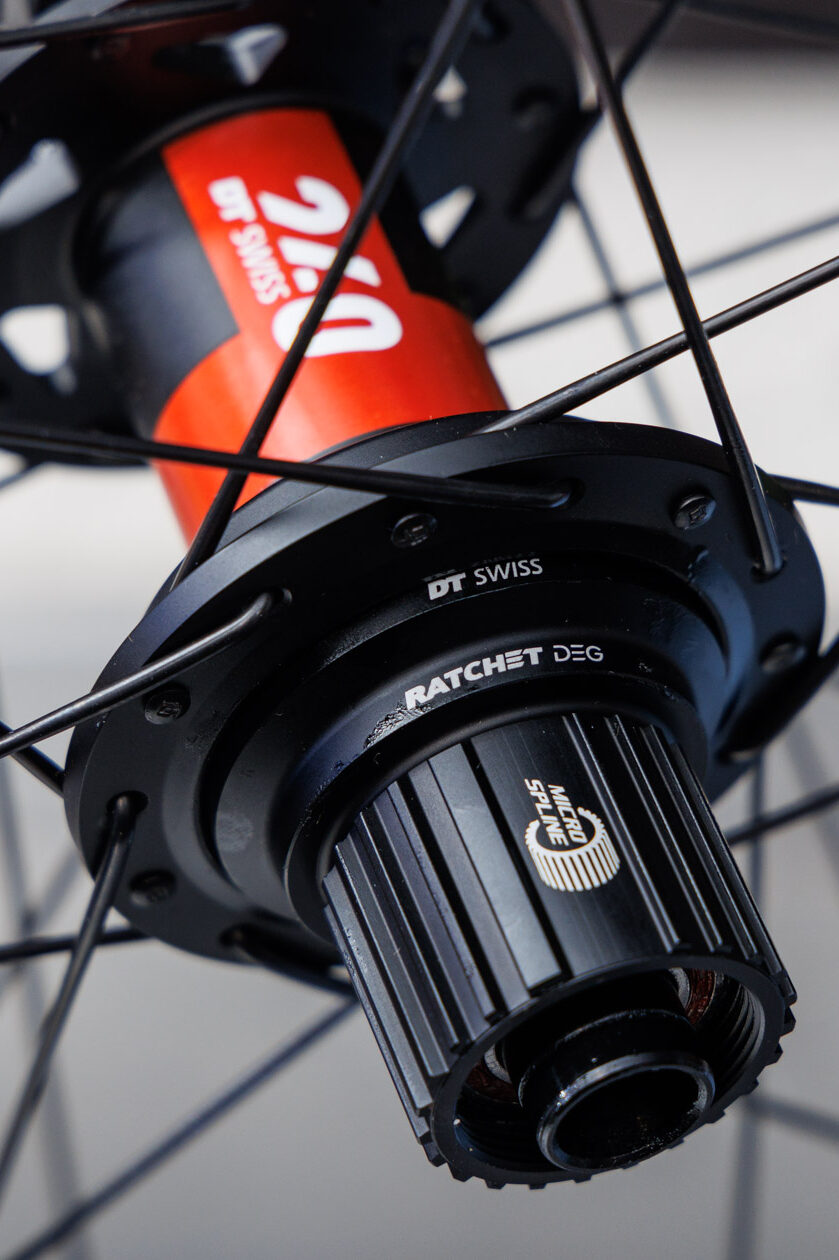There aren’t many performance-level bicycle components that have stood the test of time quite like the original DT Swiss 240 Star Ratchet rear hub. For over two decades, it remained a safe bet for anyone seeking a reliable and low-maintenance hub for mountain biking, road racing, or even long-distance touring.
Recent years saw DT Swiss reimagine the design in pursuit of fewer grams with its EXP range. Still, a large segment of the premium mountain bike market remained disinterested in the company’s relatively mediocre points of engagement at the freehub.
Today DT Swiss has unveiled a third iteration of the famous ratchet rear hub. It’s called Ratchet DEG and with 90 points of engagement, it marks DT Swiss’ entrance into faster engaging mountain bike hubs.
I’ve spent a few months on a pre-production version of this new rear hub and share some thoughts below. There’s also a special episode of the Geek Warning podcast where I interview Friso Lorscheider and Brandon Wold from DT Swiss about this new hub, how it fits into the company’s line-up, plus some chat about new spokes, spoke selection, and how to understand the company’s wheel range.
The 240 front hub has not been changed, so here, I’ll solely focus on the new rear hub.
Highs: Competitive points of engagement, one of the lightest higher tooth-count options, looks to continue DT’s stellar reliability, arguably the new benchmark for ease of service.
Lows: Heavier than a 240 EXP hub, more engagement points means more friction in coasting, a small washer between the hub and freehub body awaits to be lost, same bland style. Plus, my pre-production sample experienced two mystery skips and some higher seal drag that I’m told are both solved for production.
Price: US$500 / €377 / £355 / AU$600
Star Ratchet history
DT Swiss acquired the original Hugi Star Ratchet design in the early 90s, and by 1994 had brought it to market to become more than a spoke manufacturer.
At the foundation of the patented hub design were two ratchet rings that would securely lock together when driven forward, a design that evenly spread the pedalling loads through the driveside of the hub. By contrast, most other hubs on the market at the time were pawl-based, where typically two or three small steel prongs flip up and bite into a toothed ring for pedalling engagement.
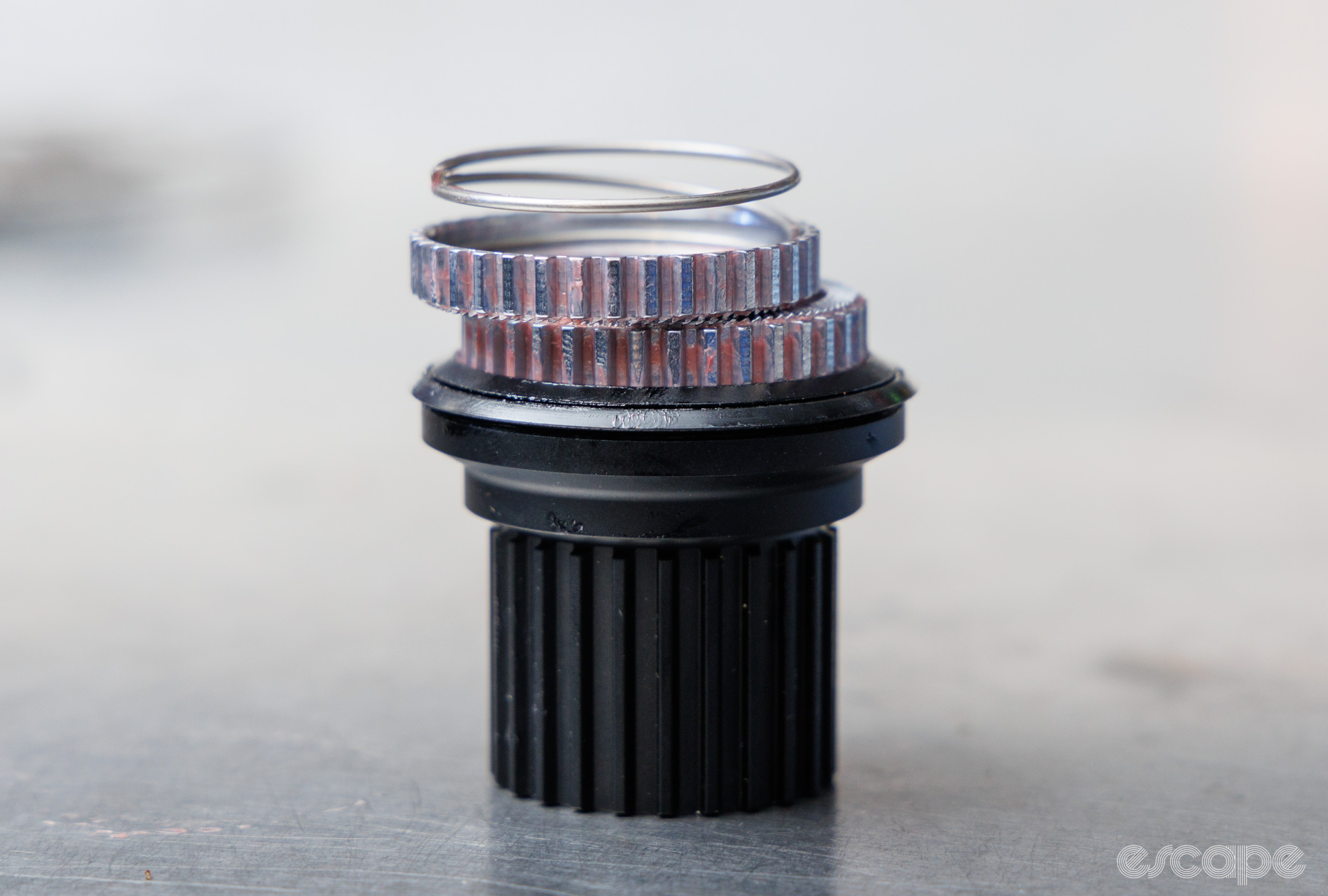

By the 2000s, the reputation of DT Swiss’ Hugi hubs was so strong that at the time it felt every second premium wheel featured the Star Ratchet internals of a 240 hub. Wheels from Bontrager, Roval, Lightweight, Giant, Ritchey, Enve, Syncros, and others all rolled with such internals (many still do), and as a result, access to spare parts was bliss.
After an incredible run, that original patent came to an end a few years back. Soon we saw copies of the Star Ratchet design bubbling to the surface, and more recently we’ve seen the volcano burst.
As that patent came to end we also saw DT Swiss look to reinvent its famous hub. In 2019 the Swiss manufacturer released the 180 EXP, a premium racing hub that – for the first time in nearly 25 years of DT Swiss doing hubs – introduced a new and not-backward-compatible ratchet system. The goal of the EXP system was to increase the performance of the hub by reducing weight through fewer moving parts (just one floating ratchet ring) and increase hub stiffness by spacing the bearings further apart.
A year later DT Swiss released a 240 version of its EXP design, signalling that the reign of that original Hugi Star Ratchet design had come to a close. Today, spares for the original Star Ratchet hubs remain readily available, and DT Swiss continues with the design for its Taiwanese-manufactured 350 and 370 hub ranges.

Through all of this, DT Swiss continually met criticism within the mountain bike world for the relatively low points of engagement afforded by the small Star Ratchets. It answered this in 2009 with an upgrade option to increase the original 20° of engagement (18T) to 10° (36T), and then later came a 54T option (which carries a so-so reliability track record amongst the high-powered pedal mashers). Still, all of these were a far cry from the near instant engagement offered by likes of Onyx and Industry Nine, and still less than the 5° engagement figure of Chris King which too uses a ratchet-based engagement system.
At the core of the problem is that the original Star Ratchet design, (initially intended for just 18T), was too small to add a competitive number of teeth to it while retaining the reliability. In an effort to keep things light the EXP hubs didn’t improve on this metric, and so, DT Swiss had left the door open for mountain bikers to leave the Swiss house in search of faster-engaging options.
And that history lesson brings us to DT Swiss’ latest product release – the Ratchet DEG. In the simplest sense, it’s an oversized version of the original two-ring Star Ratchet system, now with enough room to afford the 4° (90T) of engagement comfortably.
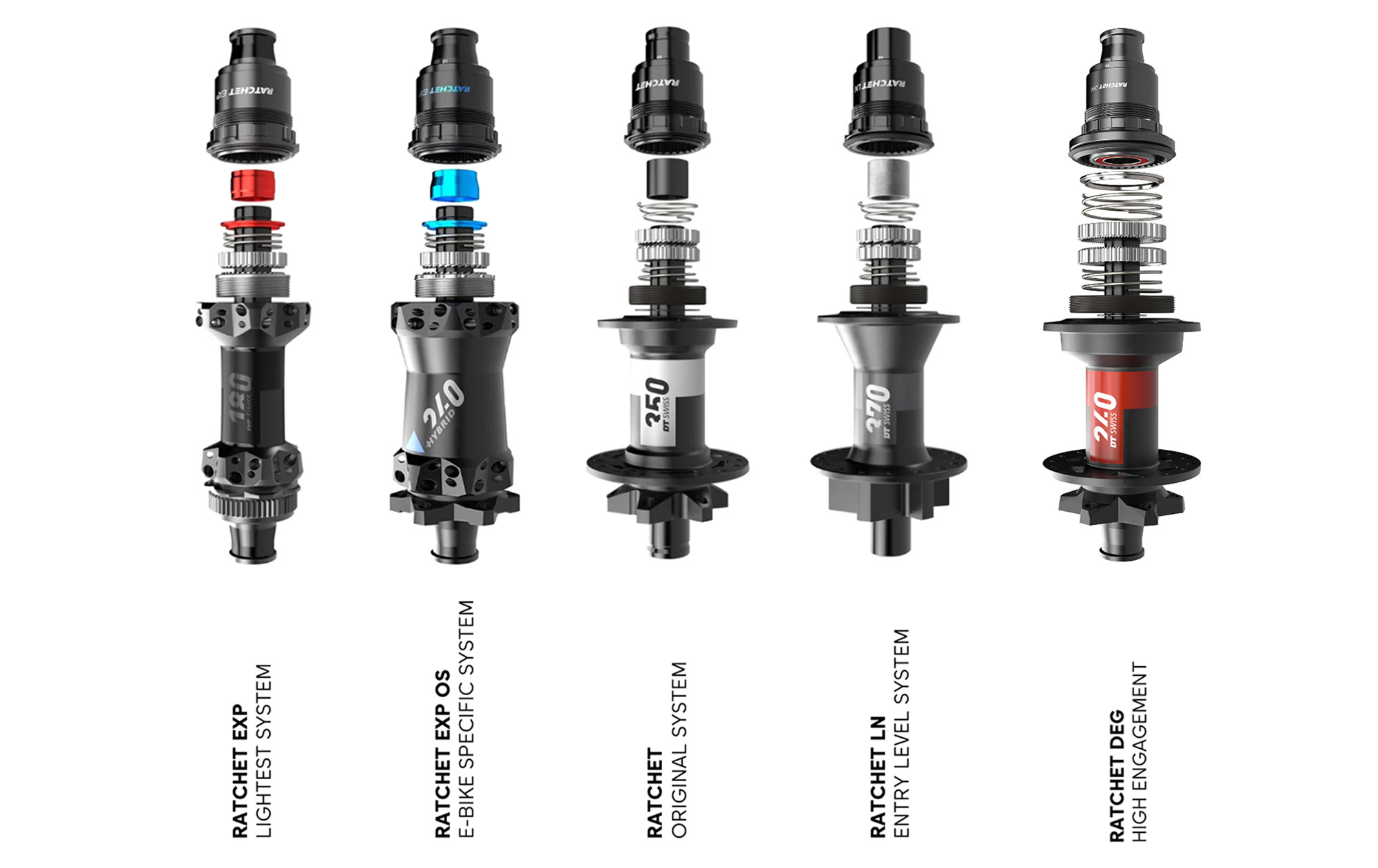
A closer look inside
Those familiar with DT Swiss hubs will spot the new DEG rear hub from afar. From the outside the driveside of the hub is now greatly enlarged and with a square profile below the spoke flange to provide room for what’s inside.

Simply pulling on the freehub body (no tools required) gives full access to what’s inside. There you’ll find DT Swiss has returned to its original two-piece Star Ratchet concept, with each toothed ring floating on its own large spring (the rear hub has two springs in total). The concept may be the same, but the specific execution certainly isn’t.
Those ratchet rings are now so massively enlarged that they’d easily surround the original Star Ratchets if you had both in your hand. By my measurement, the original Star Ratchet rings are 27.6 mm in diameter, while the new DEGs add a whole 10 mm to that figure.
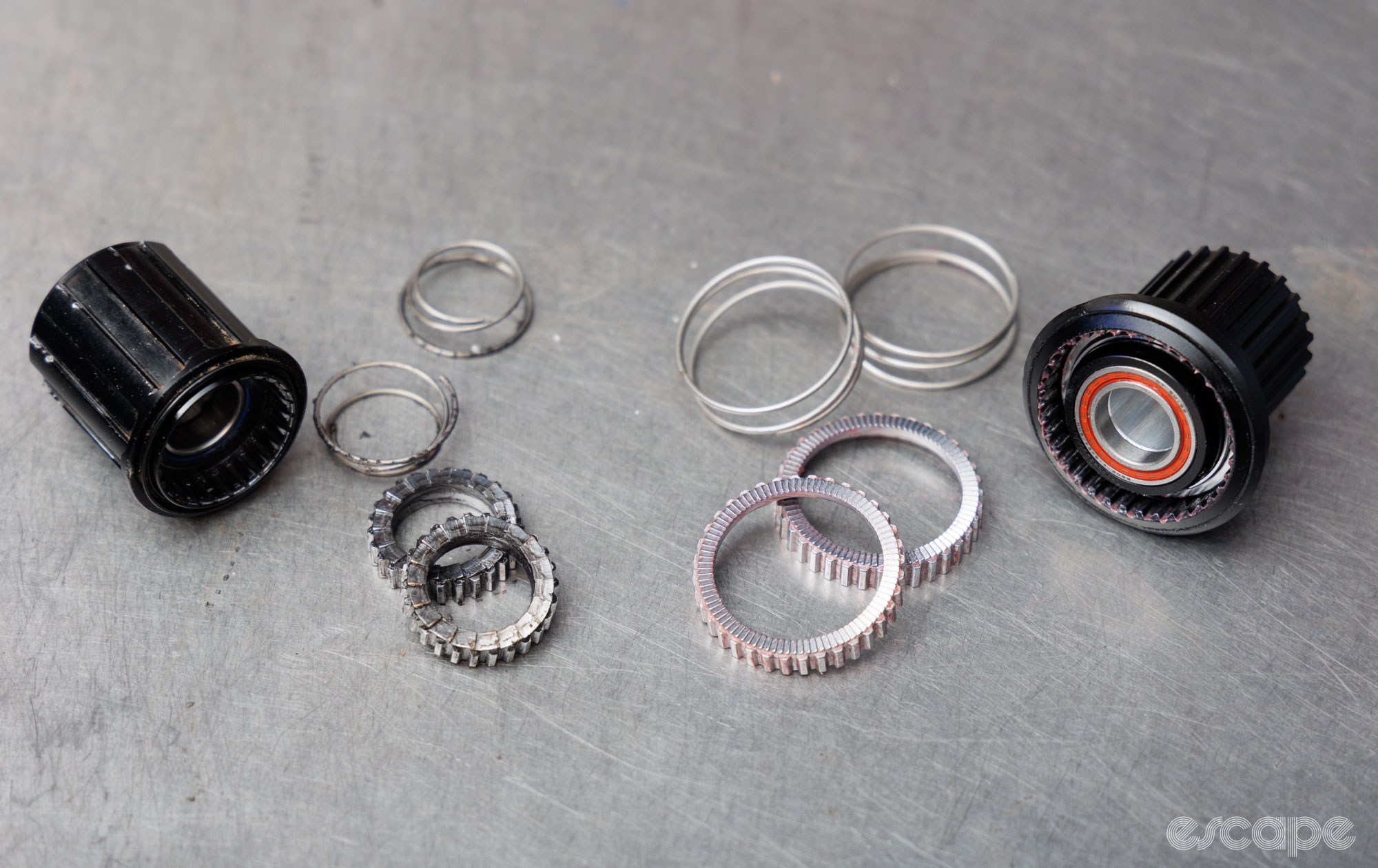
DT Swiss has then made full use of this newfound real estate by moving both the drive-side hub shell bearing and inner freehub bearing to sit within the ratchet rings and nearly touch each other. In fact, those two bearings are so close that a small washer is all that divides them (careful not to lose this). This wider bearing spacing aims to improve durability further.
Enlarging the ratchet rings to surround the cartridge bearings means servicing the DEG hub is easier than ever. The driveside bearing is no longer blocked by a threaded ring that could only be loosened with a special tool. Instead, you now have a hub that is truly tool-free for basic maintenance, and needs only basic bearing tools for a complete overhaul. Meanwhile removing the end caps is now far easier and can typically be done by hand, something DT Swiss first improved upon with the release of its EXP hubs.
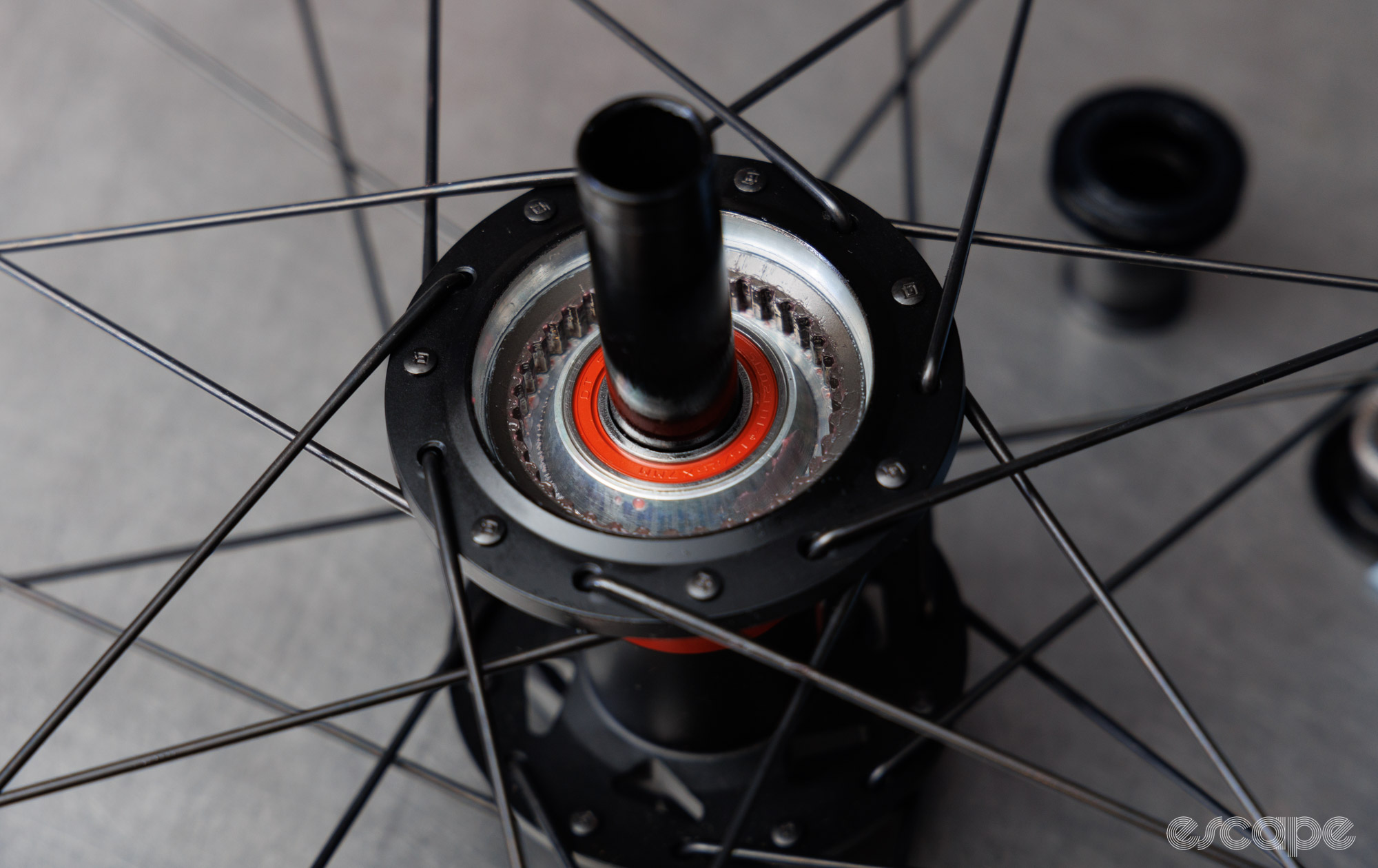

It’s important to note that the DEG system does introduce complications in backward compatibility with previous DT Swiss designs, as in, there is none. Simply put, older Star Ratchet or newer EXP parts cannot be used with new DEG hubs, and visa-versa. This is a bit of a bummer, but it shouldn’t be all too surprising.
Meanwhile the rest of the hub is a familiar affair. The hub shell is still made by DT Swiss in Switzerland, first forged and then machined for accurate bearing seats. DT Swiss continues without any form of bearing preload adjustment, rather relying solely on exacting tolerances to perform. It’s still available in any colour you want, as long as that colour is black. Or if you act fast, there is a limited edition red version to celebrate DT Swiss’ 30th anniversary (limited to 240 front and rear hub sets).
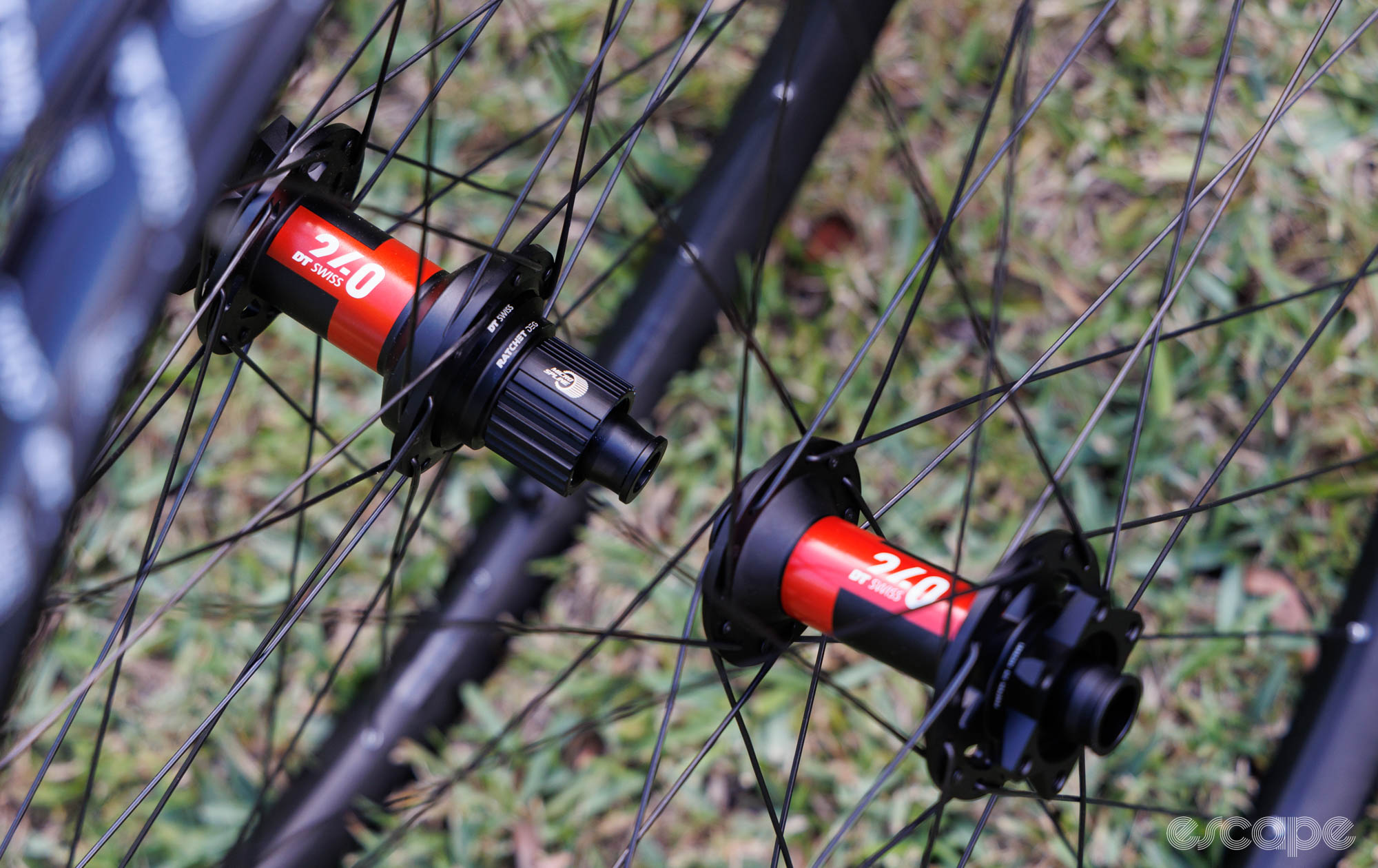
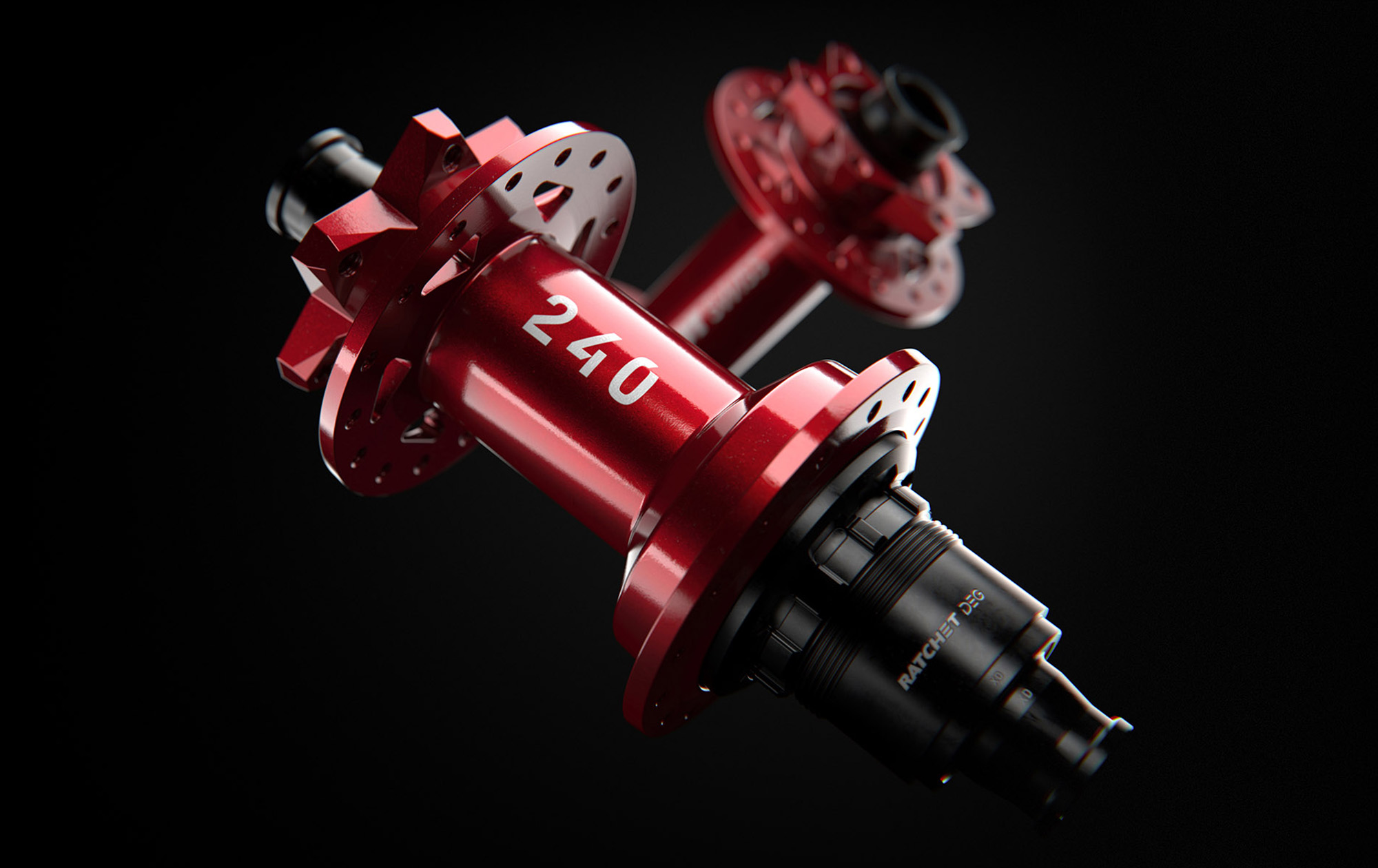
Specs
For now DT Swiss is aiming the 240 DEG rear hub at more trail, enduro and even downhill mountain bike applications, and so there are (currently) fewer variants than what you’d normally see from the company. The hubs are only available to suit six-bolt rotors. They’re only available with Classic J-bend spoke flanges in either 28 or 32 hole options. Axle widths are limited to Boost (148×12) or Super Boost (157 x 12 mm). And for now, your freehub choices are limited to either Microspline (Shimano 12-speed) or XD (SRAM 12-speed).
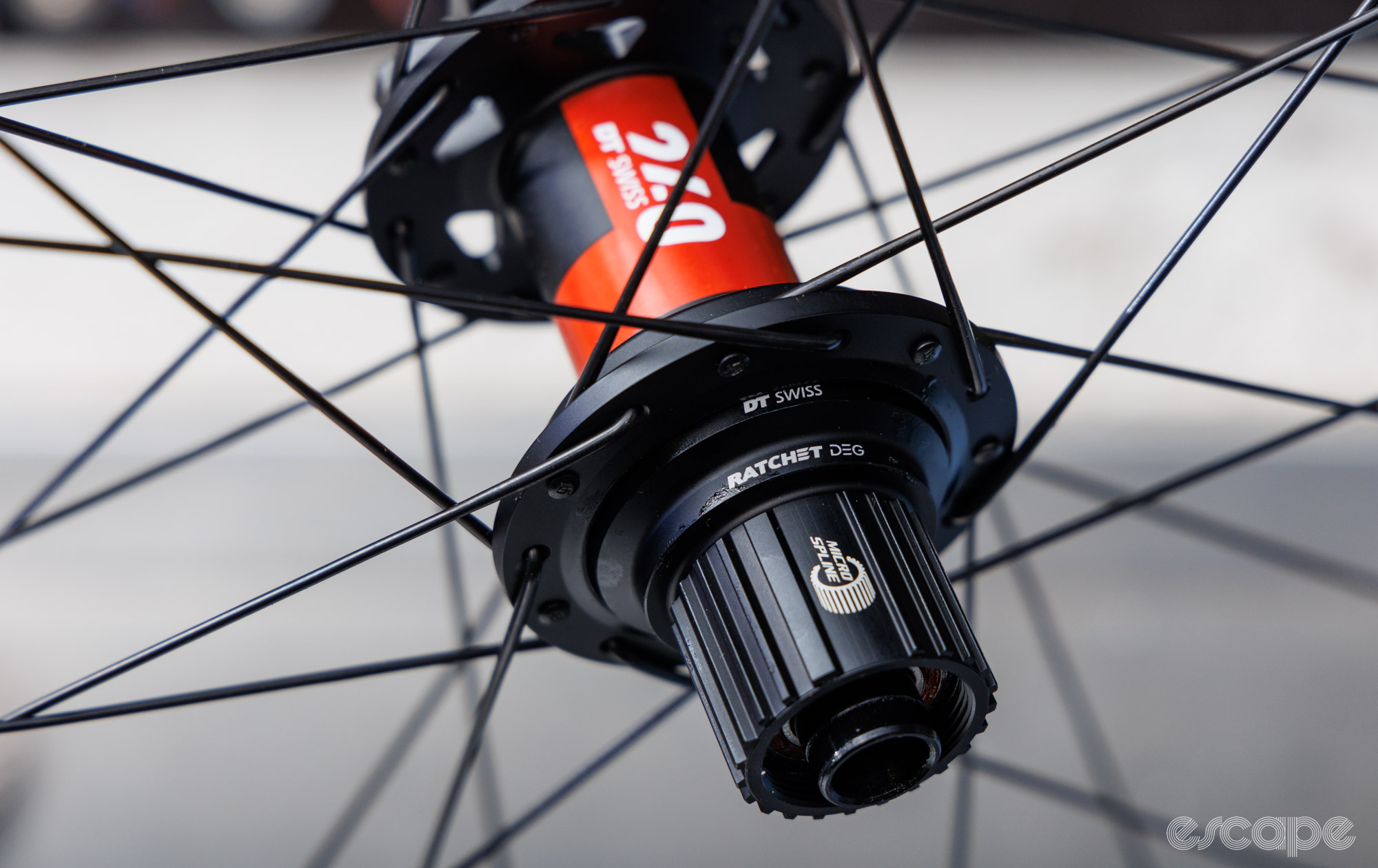
DT Swiss has teased that this is just the beginning for the 240 DEG, with an HG freehub and centerlock options expected to be added at some point. And if you listen to the special podcast episode, you’ll hear a tease of potential ratchet rings with fewer teeth (and why you may want this). That said, for now, the DEG system is limited to the standalone rear hub, or as part of the equally new DT Swiss XMC 1501 Spline One and EXC 1501 Spline One trail-oriented wheelsets.
The 240 DEG hub is approximately 40 grams heavier than an equivalent 240 EXP hub, putting it at 270 g (Boost, XD). By comparison (and according to Nobl Wheels), an equivalent Chris King ISO hub is 311 g, Industry Nine’s Hydra is 288 g, Onyx’s Classic is 458 g, Hope’s Pro 5 is 311 g, and Project 321’s new G3 is 320 g. Indeed the new 240 DEG is a lightweight amongst its competitors.
Price-wise, the 240 DEG rear hub is US$500 (€377 / £355 / AU$600), a little more than a 240 EXP at US$466 / €340.
The new 240 DEG is clearly designed specifically for mountain bikes, but according to DT Swiss, not all disciplines of mountain biking. The company believes its lighter 240 EXP is still the right choice for gram-counting cross-country riders. Meanwhile, the increased points of engagement introduce a small friction penalty when coasting, which again may not appeal to hardcore racers.
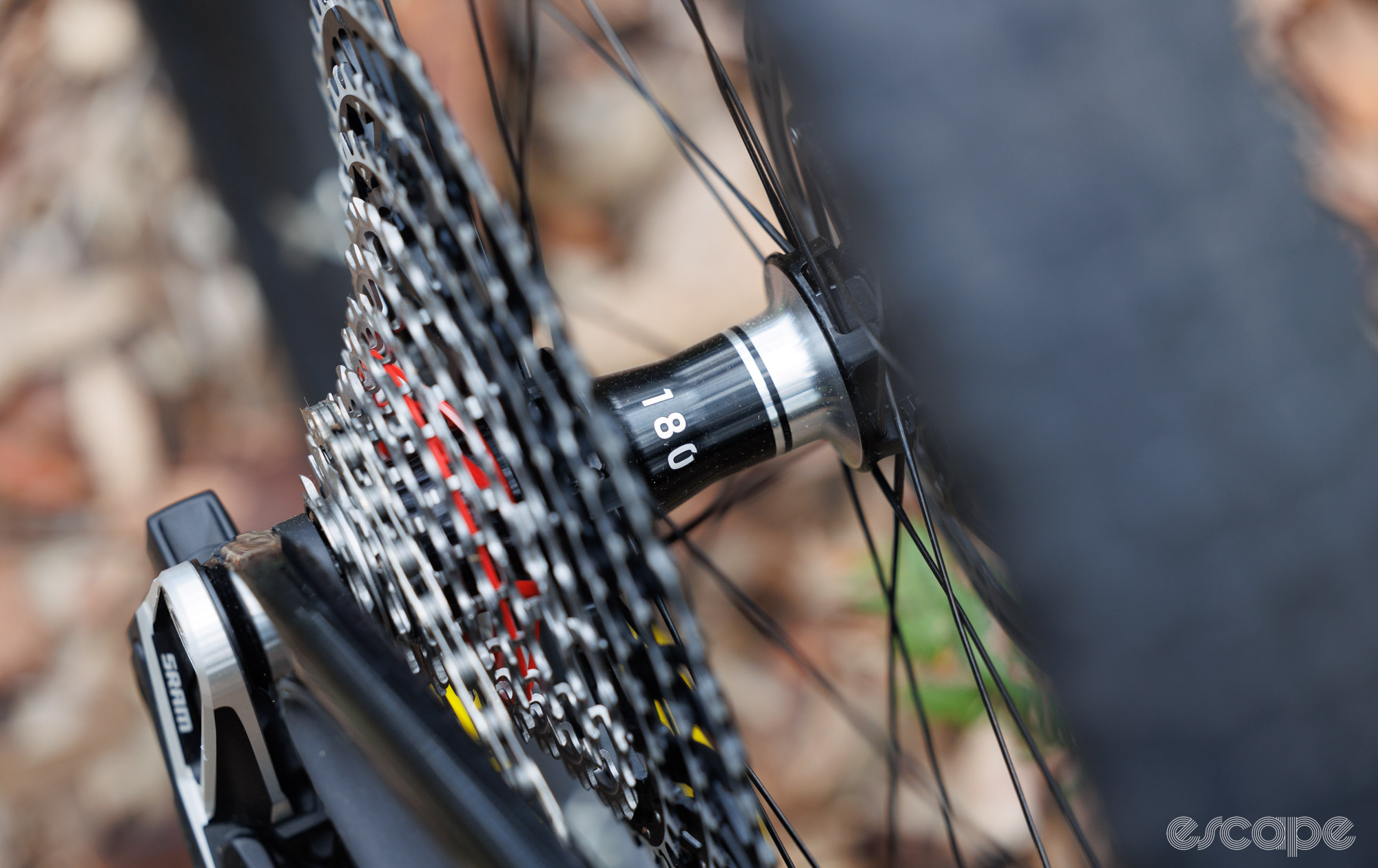
Meanwhile, DT Swiss is equally aware that some gravity riders on certain long-travel bikes actively seek fewer points of engagement to give more free play between the suspension system and chain growth. We cover this topic briefly in the special podcast interview.
Riding the 240 DEG
I’ve been testing a pre-production version of the new 240 DEG hub on my trail bike since late last year. Built with a modest specification, the Boost-width hub was laced into a pair of DT Swiss XM 481 aluminium rims with DT Competition (double-butted) spokes, weighing 1,859 g for the pair with rim tape and valves. The wheels took the spot of my Bontrager Line Pro 30s with a buzzy 108T pawl-based hub.
Straight from the box the new 240 DEG hub had DT’s usual level of bearing smoothness, with a buttery but draggy feel due to the seals within. Notably, a greatly enlarged main seal at the freehub body showed some high initial stiction that was quickly forgotten once the wheel was spinning – an element DT Swiss told me has been solved for production. Overall, the wheel spins as you would expect of a premium product and without any obvious hindrance.

In theory the DEG version will coast with more friction than an EXP hub, but I certainly couldn’t pick the difference. Similarly I’m not going to pretend that I can feel things like axle or hub flex within a frame and wheel structure. What I can say is that there was no weird creaking, no rear hub play, or obvious tightness that would cause concern.
On the trail the hubs are buzzier sounding than what I’ve become accustomed to hearing from DT Swiss. The noise level is certainly higher than the original Star Ratchet system, but less obnoxious than the newer EXP system. It’s far from a silent hub, rather being of average attention-seeking amongst higher tooth-count hubs.
Since my first set of Chris King hubs in 2006, I’ve been like a moth to light for higher-engaging hubs on the mountain bike. The 90T on the DEG isn’t breaking any records, but for me, it’s enough not to be an issue. My personal feeling is that once you’re in the 5° degree range then the diminishing effects come out to play. For example, the 4° of the 240 DEG hub meant I didn’t miss the 3.2° of the Bontragers before it, or the 1.66° of the Project 321 G3s I’ve also been riding lately.
Overall, my experience riding the hub has been positive, except for two incidents of what felt like a skip in the ratchet mechanism. Both happened during a quick jab at the pedals to clear a rock step while rolling at about 10 km/h, and both times it led to a split-second jump forward in momentum before the chain was again under tension. While intentionally trying, I haven’t been able to replicate it, and I also can’t be certain it wasn’t the chain and cassette interface (12-speed XTR chain and XT cassette).
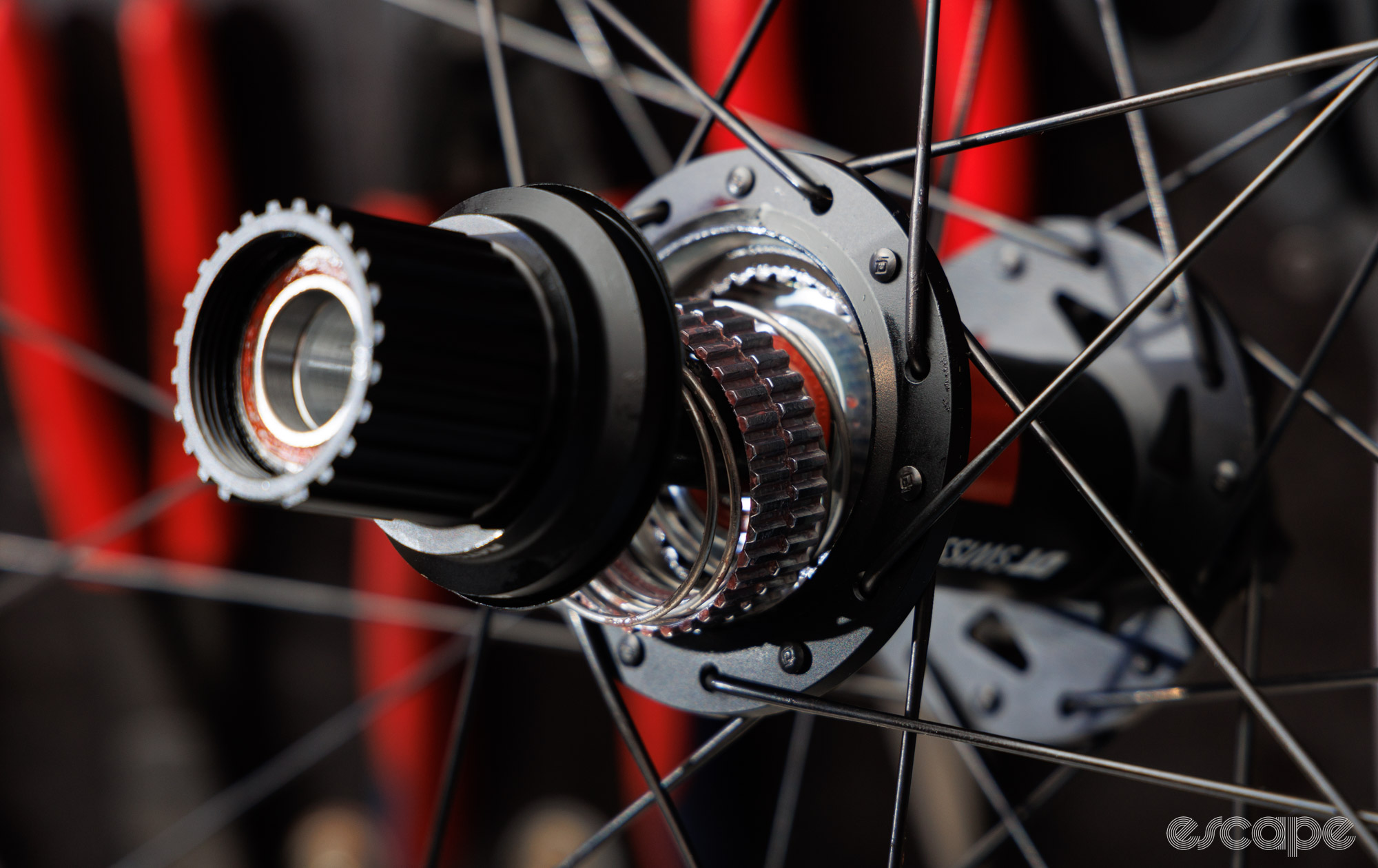
Looking inside the hub reveals zero signs of skipped teeth or the like. Either way, such skips are unwanted and it’s something I’ll continue to pay attention to given similar things have previously been reported with DT Swiss’ first 54T ratchets and the first batch of 180 EXP hubs.
Just days ago, I contacted DT Swiss for insight and a response on this issue. I was informed that my hub was pre-production and that the company had already discovered and solved this rare issue. Unfortunately, I haven’t yet tested a production hub to know if this is in fact, solved. Similarly, I haven’t been able to test whether the new DEG system is more sensitive to different (thicker) greases than pre-existing options (my gut says it will be).
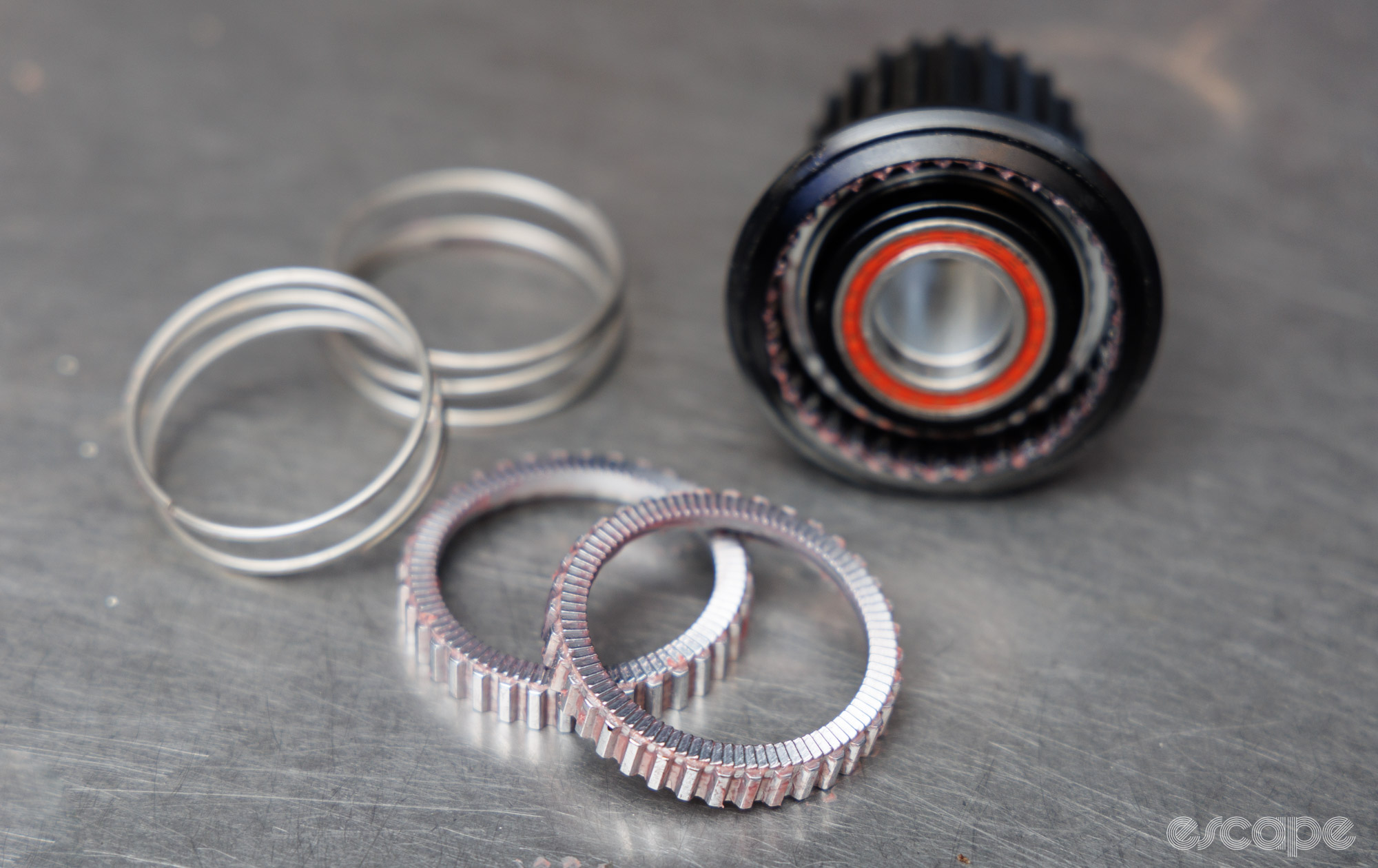
Injury and the first-world problem of too many bikes means that even after months of using these hubs I’m still no closer to seeing just how durable they are – my previous experience with 240 hubs tells me they can take years of abuse before a hint of bearing wear. So far things are running as smoothly and consistently as you’d expect of a DT Swiss 240 hub, and pulling it open shows no dirt or moisture ingress that would cause concern.
Choices choices
Adding a higher tooth count and even easier servicing to DT Swiss’ reliability track record will please many. That said, it’s clear the DEG isn’t for all. The lighter EXP system continues to be the hub for those counting grams and is what you’ll still find in DT Swiss’ newest cross-country wheel options. Meanwhile, those looking to bring a splash of colour to a bike will likely want to look beyond the bland, stickered hubs of DT Swiss.
For now, the new DEG system remains a premium option limited to Swiss-made 240 range. I’m not much of a betting person, but I’m willing to wager that DT Swiss will eventually trickle its enlarged DEG system to the more affordable 350 hub range and equivalent wheelsets. Time will tell if the Swiss company gets another 25 years of success from this one.
Did we do a good job with this story?
